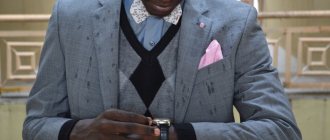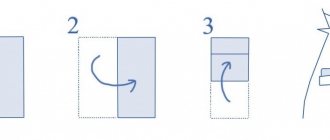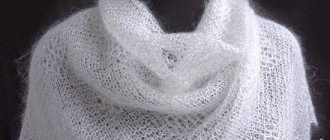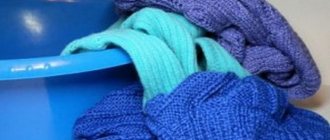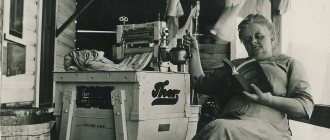How to choose a scarf
First of all, you need to know that so that the accessory does not get lost in your pocket, you should choose a copy according to size. If the scarf is made of silk or chiffon, then its range should be at least 35x35cm - 45x45 cm. For cotton, linen and cambric fabrics, the size may be slightly smaller.
The main fabrics for chest attributes are: silk, cambric, chiffon, linen and cotton. In the cold season, it is recommended to choose a scarf with the addition of woolen thread for a tweed jacket. You should not look for combinations of fabrics for a tie and a chest accessory: they can be completely identical in composition. The combination of a silk tie and a linen piece of fabric also has a right to exist.
The most optimal and versatile option is considered to be a white linen accessory. It is perfect for all occasions, be it any celebration or just a walk in the park.
You should not detain your attention to scarf accessories made from synthetic fabrics. After all, a chest piece in a jacket pocket is not a piece of clothing you should skimp on.
Where else can you wear a scarf?
In the modern world, a pocket square cannot be called an indispensable attribute of a man’s image. Many consider such an accessory, albeit fashionable, to be a rudiment: its place is perhaps on suits for special events (like weddings), clothes for official receptions, and business meetings.
The most common materials for creating scarves are silk or cotton.
However, there are men who choose such an iconic little thing for themselves as an addition to their everyday clothes (different variations of print and colors are selected; the main thing is the combination with the attire), and for special occasions.
When choosing a scarf, you need to remember that it should be in the same color scheme as your jacket or suit.
The pasha scarf is an element of an A-class suit. It is capable of imparting masculinity to any member of the stronger sex, making him a fashionista, attractive to the ladies. Therefore, the accessory may be appropriate in many cases. The main thing is correct application.
You need to make sure that its edges are processed well enough. After all, their shabby appearance can ruin the created image.
Fashion experts advise using it to enhance blazers or sports jackets. A great pair - a cardigan or blazer plus a pocket accessory - will add sophistication to a man's look.
With a delicate and artistic approach, the above-mentioned item of clothing in a men’s wardrobe will not be superfluous. On the contrary, it will add completeness to the image and become an elegant final touch. There is no need to be afraid of experiments. If you approach the matter creatively, the result will only please you.
Colors and patterns
An accessory such as a pocket square is not considered an official item of clothing. Therefore, its colors and patterns are chosen according to their intended purpose. For example, a monochromatic or small-patterned accessory would be ideal for an office employee.
For a light and free style, brighter and non-standard colors and patterns are used.
How to choose a scarf for a men's jacket in the chest pocket?
The most basic rule is that the ensemble must be complete and in harmony with all parts. There is no need for the scarf and tie to be made from the same fabric.
Basic rules for choosing a pasha scarf:
- For a plain jacket, choose scarves with figured patterns.
- Do not choose fabric that is similar in color and pattern
- The handkerchief should stand out against the background of the jacket, shirt and tie
- The simpler the jacket, the more intricate the design and method of laying the scarf should be.
How to choose a scarf for a men's jacket in the chest pocket? How to choose a scarf for a men's jacket in the chest pocket? How to choose a scarf for a men's jacket in the chest pocket? How to choose a scarf for a men's jacket in the chest pocket?
Avoid monochrome with a suit
When choosing accessories for a suit, initially take into account the combination of colors of the shirt, tie and jacket. The chest accessory does not take any part in this. It comes as a completely independent unit of the costume, but the following points must be taken into account:
The pattern on the scarf accessory should be in harmony with the pattern of the tie or shirt.
The color of the scarf fabric is chosen so that it matches the color of the main outfit, which gives the image a harmony of taste. An incorrectly selected fabric color will look ugly and indicate a lack of style and taste.
And yet, a scarf in a jacket can act as an independent element, but you need to make sure that it harmonizes with your wardrobe items and does not conflict with them.
The easiest way to combine plain scarf accessories with basic clothing items.
Try to avoid ready-made store-bought “scarf-tie” sets. This combination of accessories is considered primitive and tasteless.
But if you add a little ingenuity and imagination, you will get a truly sophisticated and inimitable image.
Beautiful pocket square styling
A nicely placed pocket square in a jacket pocket gives an eccentric and chic look to the whole look. A scarf laid in an unusual way will tell about its owner about his skill and sophistication in style, which usually delights those around him.
Shawl accessories sewn in a factory do not have the same beauty and attractiveness that can be created by folding a scarf with your own hands.
By the way, a scarf accessory is worn not only in a jacket pocket; it can be used to successfully decorate a vest if it is worn without a jacket:
And even a coat:
A scarf accessory is a completely independent element of clothing, so it does not have to be worn in conjunction with a tie.
A few more ways to wear a chest accessory:
Classic methods
The ability to improvise has always been valued. However, in the case of pasha, it is better to learn standard design techniques. They will come in handy in different cases; you should not assume that their destiny is official receptions. For a bachelor party, a scarf folded using the classic method is no less relevant.
Presidential style
The method is suitable, first of all, for a white silk or linen accessory used as part of the most classic, presentable suit. This is done as follows:
- Place the scarf folded 4 times so that the fold is on the left, and the free ends are in the upper right corner;
- fold the left edge over to the right (you need to bend it in the center);
- bend the lower part upward (bend should be in the center);
- make sure the loose ends are still in the top right corner and the fold is on the left;
- place the accessory in your pocket.
Wedding style
It is necessary to choose a design method based on the style of the event and the style of the jacket . A formal suit will be transformed by combining it with a pasha folded at a double angle. The winged bouffant, as well as the presidential technique, are also quite appropriate. It's worth trying a polygon too. It folds out as follows:
- fold the triangle so that the bend is at the bottom, and the upper corners are not aligned (at this stage the figure has only two corners);
- Fold the bottom left edge up to form a 3rd corner;
- bend the right one in the same way as the left one (a 4th corner will appear);
- align the right and left corners in the middle slightly overlapping;
- bend the bottom cut upward, but not too much, since it should not extend beyond the edge of the pocket;
- place the structure in your pocket.
Angle
A universal option that meets any dress code . Requires a classic accessory.
Instructions:
- fold the scarf into four;
- turn over into a diamond position (the free ends are facing down, and the fold is facing the upper right corner);
- place the bottom edge over the top (bend it in half to form a triangle);
- visually divide the left side of the triangle into 2 parts;
- bend the left side along the visually marked middle;
- repeat the procedure on the right side;
- put it in your pocket.
Two corners
If you take a plain scarf, the look will turn out to be formal. Color will soften the severity. Step-by-step instruction:
- turn the accessory folded in four so that you get a rhombus, the fold of which is the lower right side;
- visually divide the lower left side into 3 equal segments;
- do the same with the upper right side;
- count from the bottom corner on the left side 2/3, mark a point;
- count from the upper corner on the right side 2/3, mark a point;
- fold the scarf along the designated points;
- visually divide the bottom edge into 3 equal parts and bend the left corner at 1/3 of the bottom;
- repeat the process with the right corner.
The accessory is ready for use.
Three corners
- fold the pache diagonally so that the corners are slightly offset from each other;
- bend the left corner towards the top so that you get a kind of trident;
- Decorate the right corner in the same way and put the pocket square in your pocket.
Volumetric cloud
A somewhat informal solution. The most beautiful method is implemented with bright silk handkerchiefs .
The accessory will have to be unfolded. A cloud is formed from its central part, and the ends free from the structure are sent down into pockets. If you put them outside and send the formed cloud down, you will get one of the variations of the “boof” or an inverted version of the cloud. It will have to be adjusted directly in the pocket itself - a very difficult task for those who do not have experience or do not have enough patience.
Another way to form a “cloud”:
- take the scarf by one end and let the rest hang down;
- with the other hand, squeeze the pasha approximately in the middle;
- release the first hand;
- fold the lower free edges closer to the middle (tuck them under the fingers);
- put the resulting figure in your pocket.
Winged buff
The perfect solution for a silk pocket square. The design is carried out as follows:
- rotate the straightened accessory to form a rhombus;
- fold the top edge over the bottom;
- bend the left and right ends to the top;
- fold the right and left edges again towards the center;
- lift the lower end up;
- The paste is ready for use.
You need to insert an accessory folded in this way so that the folds face outward , that is, they are visible.
One for beauty, one for cleanliness
It's no secret that the scarf in your pocket plays an important role in the created image. And if an unforeseen situation arises, in the form of dirty hands or suddenly appearing snot, the chest accessory should not be used as a life preserver. For such unforeseen situations, you need to carry cotton scarves in your trouser pocket.
And even if you had to use a chest accessory, you shouldn’t put it back in your jacket pocket. Otherwise, the image will be hopelessly spoiled and you can easily be considered an unkempt and slovenly person among others.
You need to keep an eye on your chest accessory throughout the day so that it doesn’t become fluffy or get out of the pocket. The intended accessory to create an image must be perfectly folded and inviolably clean.
Styling a pocket square
At a wedding or other significant celebration, you can often meet men with a chest pocket accessory in combination with a boutonniere.
Modern gentlemen, although rare, are also found in everyday life, with beautiful additions like a pocket square and a boutonniere.
How to fold creatively?
Straight and diagonal folds are a very unusual approach to the issue of designing a pocket square. The part protruding above the pocket looks like several cubes . To fold, you will need to do the following:
- fold in four;
- place it in front of you like a square or diamond;
- make a narrow fold, slightly turning the bottom up;
- make another 3-5 folds;
- fold the handkerchief in half.
Ready. Place the decorated pache with the fold facing outwards.
